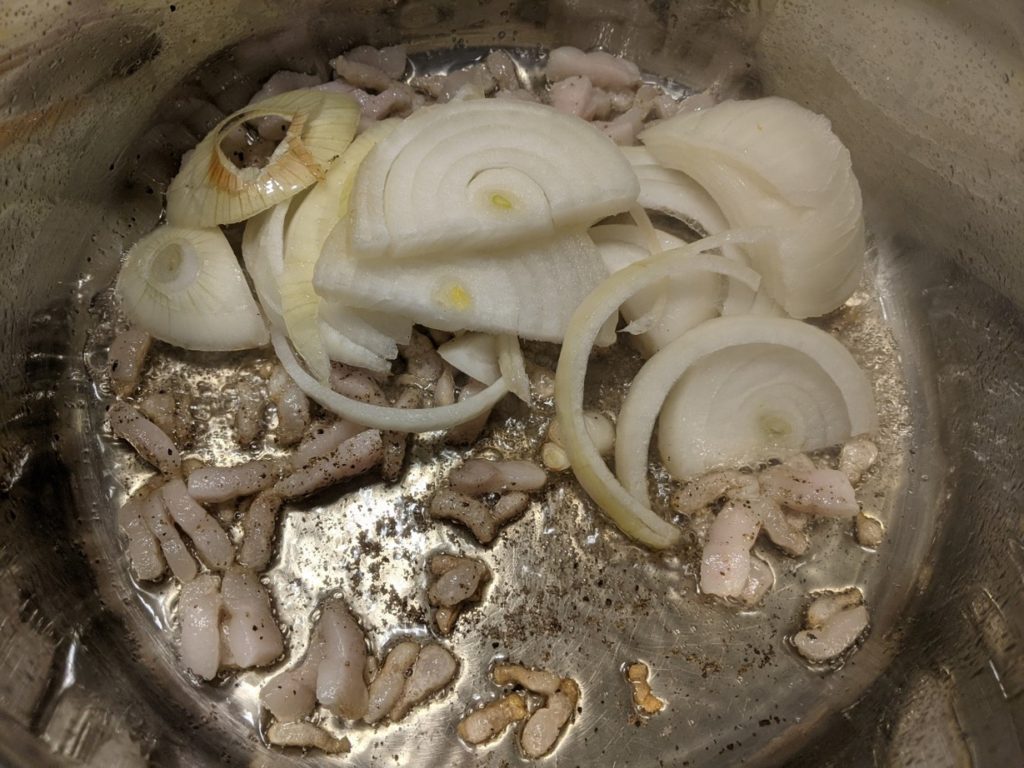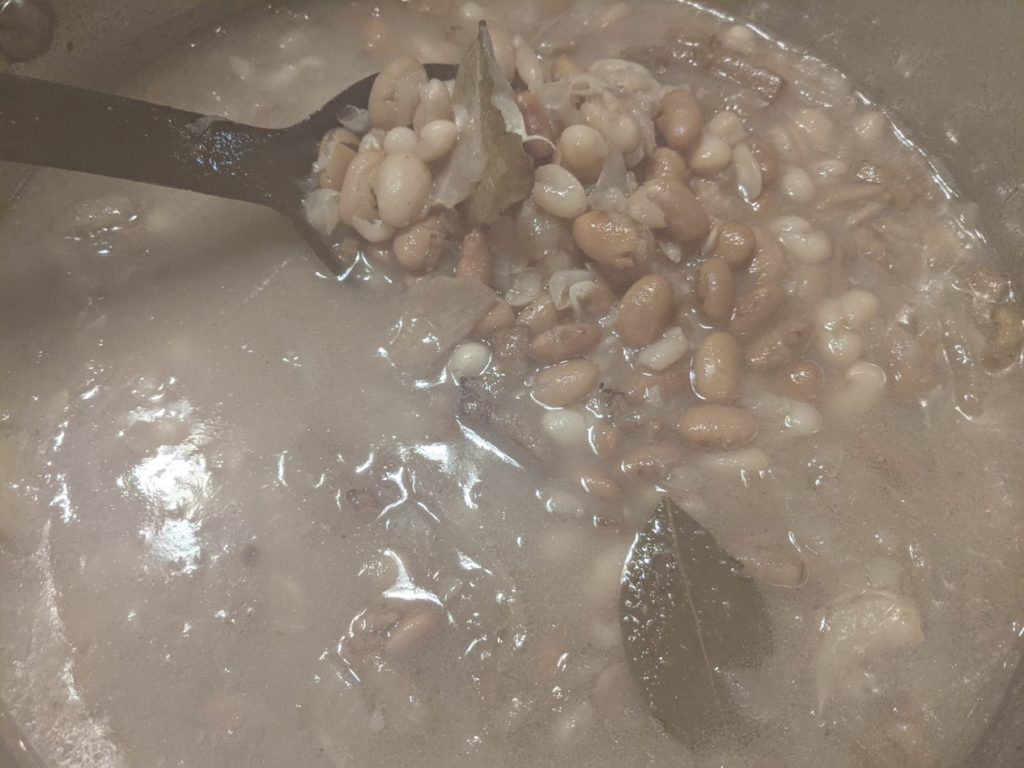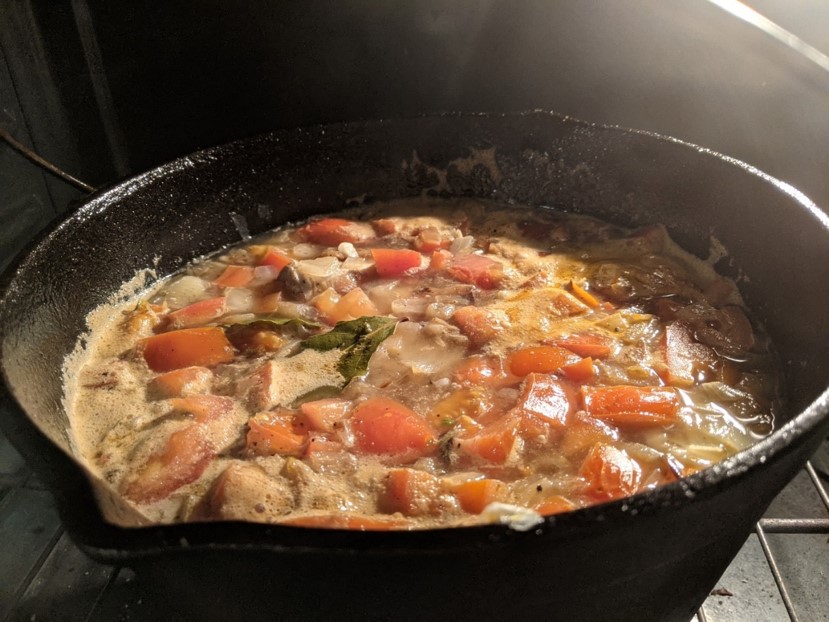Cassoulet de Dinde Sauvage

This recipe utilizes wild turkey 1 leg, 1 thigh, 1 wing, neck, back, and ribs
By: Olivia Menard
The Garonne River charges inland form the Atlantic Ocean, then away from the Dordogne along the banks where the Medoc terroir enriches to that of the grand Bourdeaux. Hundreds of years of study and several failed attempts by the world’s greatest minds, including Leonardo da Vinci, went into linking the Garonne to the Mediterranean Sea. Connected today to both the Mediterranean and the Atlantic by the Canal du Midi, the city of Toulouse sits at the heart of it all. Cassoulet originated in the Occitanie, and is often eaten today within view of a commercial aircraft fuselage or engine floating along the canal in transit from one manufacturing plant to another.
Cassoulet originated in the pre-French Revolution province of Languedoc. Notable towns in this region are Toulouse, Castelnaudary, and the medieval fortress of Carcassonne. Each provincial town makes their own traditional cassoulet. All versions feature some mixture of locally sourced white beans. Pork, goose, or duck, may be used, depending on which city you are in and which meat was historically most readily available.
Cassoulet is named simply for the deep, round, earthenware pot used to cook it – a casserole with slanting sides. Preferably one that has been deglazed from the last cassoulet to make the base for the next. The continuity of typified use building on the experience over time in a style mimicked by the bakers in San Francisco who have nurtured the same sourdough starter for hundreds of years. No two meals ever to be identical. Each with its own cast of flavors and smells.
Cassoulet is a rich hearty meal in and of itself. Serve alone, with yeasty rolls, rustic crusty bread and butter, or a green salad and fruit.
Appropriate wine pairings include a strong, dry white or rosé. Although not French, a crisp acidic sauvignon blanc melts the fats of this dish into velvet, too.
Serves 6-8 Prep time 1.5 hr Cook time 6.5 hrs Total time 15 hrs
For the Beans:
8 Quart stew pot
2 cups dry white beans (Great Northern, or pinto, or garbanzo all work very well)
½ lb pork fat back
1 cup onions, cut in half then sliced somewhat thinly
8 garlic cloves, unpeeled, crushed
2 whole cloves
½ tsp thyme
2 bay leaves
1 T salt
Pepper, to taste
For the Turkey and Sauce:
8 Qt cast iron Dutch Oven, 5-6 inches tall
2-1/2 lb wild turkey (about 1 leg, 1 thigh, 1 wing, plus neck, back, and ribs) If the ribs are used, make sure to remove the breasts and reserve. Darker meat works best in this dish as it more closely relates to the traditional duck meat used in Toulouse.
4-6 T rendered fresh pork fat, or cooking oil; more, if needed
2 cup onion, minced
8 garlic cloves, minced
4 large tomatoes, chopped
½ t thyme
2 bay leaves
1 cup dry vermouth
Pepper, to taste
For the Sausage:
1 lb mild pork sausage
A big pinch of Allspice (or equal smaller parts nutmeg, cinnamon, cloves)
1/8 tsp bay leaf, crumbled
1/4 cup Cognac
1 small garlic clove, mashed
1/4 tsp Truffle salt
1/8 tsp pepper
For the Top, if you’d like:
1 wild turkey leg
Steps:
- Soak beans overnight in cold water.
- Cut pork fat back into strips ¼ inch wide. Then cut strips into small triangles.
- Drain and rinse the soaked beans.
- Heat fat back triangles and onions in stew pot over medium high heat until they start to brown.
- Add to the pot, the unpeeled, crushed garlic cloves, whole cloves, thyme, bay leaves, and pepper. Heat about a minute, stirring often, just until the herbs become aromatic.
- Add the beans to stew pot. Cover everything with fresh cold water. Bring to boil. Reduce heat to low and simmer uncovered, until the beans are just tender, about 1-1/2 hours. Add additional water, as necessary, to keep the beans covered with liquid.
- Remove beans from heat when finished. Transfer beans and cooking liquid to keep covered in cooking liquid until ready to use. Discard bay leaves and whole cloves.
- Meanwhile, preheat oven to 325°F.
- Cover the bottom of the dutch oven with a thin layer of pork fat, then heat on medium high just until the oil starts to smoke. Sear the turkey wing, thigh, and one leg on all sides until the skin is browned and beginning to crisp. You may need to work in batches, setting the seared pieces on a dish separate from the raw pieces as you go.
- If using additional parts of the bird, brown all the bones, too. Push them down in the pot or break the joints before adding to the pot to carmelize all the proteins.
- It may be necessary to add additional fat as you work. If the fat burns, discard it and add fresh.
- After all of the turkey meat and bones are seared, lower the heat to medium and add the minced onions to the dutch oven with a bit of oil. Stir and heat until just browned.
- Add minced garlic and stir just until garlic becomes aromatic.
- Return the seared turkey meat and bones to the dutch oven and stir in tomatoes, thyme, bay leaves, vermouth, and pepper. Cover everything with water. Bring to a simmer, uncovered. Then cover and simmer slowly in the oven at 325°F, for about an hour. The meat is finished when the bones pull easily and the meat separates easily when touched with a fork.
- Remove the meat and bones to a dish. Let cool enough to sort through the meat and hand pick out all of the bones and crunchy or chewy bits that remain. Transfer bones, unsavory bits, and bay leaves to your stock bag for use at a later time.
- Skim off all but 2 tablespoons of fat. Adjust seasoning to taste.
- Mix sausage thoroughly with allspice, crumbled bay leaf, cognac, smashed garlic clove, truffle salt, and pepper all together in a bowl. Let soak at least 20 minutes.
- Heat sausage mix in stew pot set over medium heat until lightly browned and crumbled.
- Transfer cooked beans, braised turkey, and leftover braising sauce into the stew pot with the fully browned and crumbled sausage. Add enough reserved bean cooking juice to just cover everything. Add a bit of water if there aren’t enough reserved liquids.
- Bring to boil. Reduce heat to low and simmer gently until whole stew has a chili like consistency. 1-2 hours.
- About a half hour before serving, preheat oven to 325°F.
- Heat 2 tablespoons of fat in the bottom of the dutch oven or a cast iron skillet over medium high heat until it just starts to smoke. Sear the remaining turkey leg on all sides until the skin becomes crispy and browned.
- Transfer the seared turkey leg and its juices to a roasting pan or skillet and slide it into the oven to roast until done to your preference. This piece should be roasted through. Still firm enough to slice, but not so done that it flakes apart when cut. When the right consistency is met, transfer roasted turkey leg to a plate to cool
- When sausage, turkey, and bean mix in stew pot reaches desired consistency, ladle some into each serving bowl.
- Slice the roasted turkey leg into ½ inch thick pieces with crispy skin attached. Lay 1 piece of sliced roasted turkey on top of each bowl of sausage, turkey, and bean mix. Serve while the roasted turkey skin is still crisp.

Olivia can be found on Facebook @ Olivia M Menard and on Instagram at @oliviammenard
















